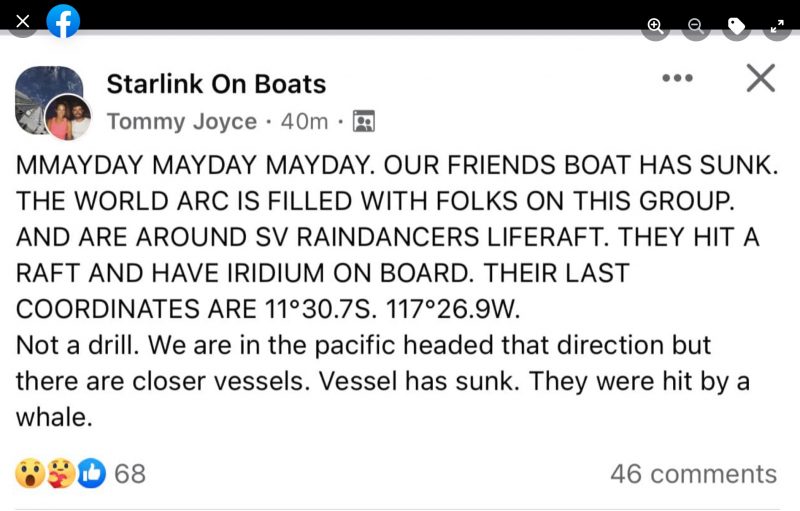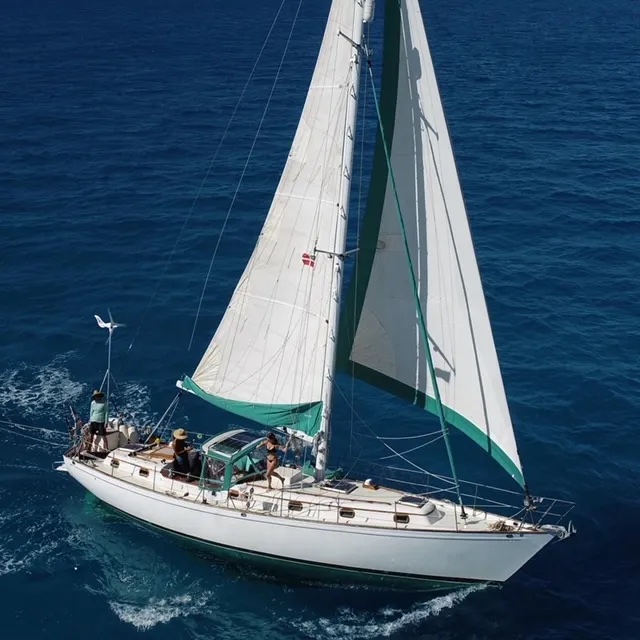
Sailboat Sinks After Collision with Whale in South Pacific
It was like an excerpt from a Herman Melville book: “Vessel has sunk. They were hit by a whale.” Those words were shared across social media channels on Monday as sailors networked to send aid to the stricken crew of Raindancer (we believe a Kelly Peterson 44). Also in the shared post were the words “Not a drill.”
The post was created by Tommy Joyce, a member of Facebook’s “Starlink on Boats” group. Tommy is a friend of Raindancer‘s owner, Rick Rodriguez, and was alerting the boating community to the situation. “They hit [have] a liferaft and have Iridium on board.”

They were almost in the middle of the Pacific with no other boats in sight. But a successful rescue was coordinated through the power of social media and modern communications, including new kid on the block Starlink.
We contacted Paul Tetlow, managing director of World Cruising Club, who is operating as “rally control” for the World ARC cruising rally. He told us that upon learning of Raindancer‘s demise and the position of the crew, he contacted the Maritime Rescue Coordination Center (MRCC) who then assigned MRCC Peru to coordinate the rescue. But before the official rescue had been executed, a network of communications had quickly arisen, much of it via Starlink, and around eight ARC vessels diverted their course to assist Raindancer‘s crew. Along the way, ARC participants aboard S/V Far were able to keep up the communications with the lifeboat using Iridium and Starlink.
Here’s what we understand about the incident. Raindancer was “13 days into a 20-22-day, 3000nm ocean crossing,” Vinny Mattiola wrote on Facebook, when the vessel was struck by a whale, which “damaged the skeg and prop strut, and the boat was completely underwater in <15mins, forcing all four crew to abandon into the life raft.” They were approximately midway between the Galápagos and French Polynesia.
Fortunately the crew were cool-headed and quickly loaded the raft with water, provisions, and emergency communications and survival equipment, and secured Raindancer‘s dinghy alongside. Mattiola believes the crew’s Iridium GO! device, which they carried along with their SPOT tracker, was instrumental in their rescue.
Within 10 hours of Raindancer going under, her four crew were rescued and taken aboard the sailing vessel Rolling Stones. “A very quick response time,” Tetlow said. “A good achievement.” Tetlow believes Starlink adds “another layer of ability to solve problems quickly,” and that the Starlink communications probably did add to the expedience of the rescue.
According to reports, the boat’s EPIRB hadn’t worked as intended, but the US Coast Guard later confirmed that it had indeed worked, the crew just “didn’t know it.” When we learned of Raindancer‘s distress, we contacted Douglas Samp, USCG Search and Rescue Program Manager for the Pacific, and Kevin Cooper, Search and Rescue Program Manager, Hawaii, who were already coordinating rescue with MRCC Peru. Samp later explained, “There is no country in the world that has SAR resources able to respond 2400 miles offshore, so we rely upon other vessels to assist. RCC Alameda assisted MRCC Peru with a satellite broadcast to GMDSS-equipped vessels and diverted an AMVER (Automated Mutual-Assistance Vessel Rescue) vessel, M/V DONG-A MAIA, to assist, but the Rolling Stones got there first. BZ to your sailing community for rescuing your own.”
Mattiola concluded his post: “All crew are safe and even sent me a voice message thanking everyone involved.”

We hope to share more about this story in the next issue of Latitude 38.
*Editor’s note: Upon learning the full details of this story, the headline was changed from Sailboat Sinks After Being Rammed By Whale in South Pacific toSailboat Sinks After Collision with Whale in South Pacific.

Seems the whales are trying to get even.
So glad everybody is safe! Kudos to the rescue team
It would be an interesting study to determine if there’s a correlation between whale strikes and the color of bottom paint.
A bit over the top on the title. “Rammed”? Really. Rammed implies the whale was trying to damage the boat. Do we even know if the boat hit the whale rather than the whale hitting the boat?
Exactly what I was thinking
The boat hit the whale. To say the opposite is just incorrect. Bad reporting.
The whale struck the boat. Scientists believe they associate boats in that area with whaling. Same thing happened around that area about a year ago.
This may have to go to litigation. Some say the whale was double-parked with one taillight out when the Pacific highway was busy with the World ARC Rally, PPJ Rally and other westward-bound cruisers.
It is roughly where the whaling ship Essex, which sailed from Nantucket, was sunk in November of 1820 when it was rammed/attacked by a vengeful sperm whale. The story laid the foundation for Herman Melville’s book ‘Moby Dick.’ The actual story of the sinking of the Essex is told in a great book by Nathaniel Philbrick in his book, “The Heart of the Sea.” Once again the whale didn’t get to tell their side of the story but it certainly might have included the fact that the whaling ship was out there trying to kill it. In 1820 whaling ships were starting to hunt for whales to the west of the Galapagos after major populations of whales in the Atlantic had been depleted. Moby Dick and The Heart of the Sea are both worth a read. Have a look in the Latitude 38 bookstore: https://bookshop.org/shop/latitude38
Hi John,
Even if the whale did hit the boat (which is a really hard thing to determine at sea), using the word ‘rammed’ implies intent. And, except for the orca problems off of Gibraltar, and Moby Dick, I don’t think we can attribute intention to the whale. It just sounds sensational.
As for whales associating boats in that area with whaling… that’s a hard one to believe. Many thousands of boats have sailed safely through that area since whaling was banned.
Cheers,
Bruce
Oh, and by the way, I thought the movie THE HEART OF THE SEA was excellent. One of the few sailing films that treated the sailing parts realistically. They were never turning the wheel to port and the ship would go starboard!
I was also thinking ? the same thing. Striking a whale that was “perhaps” (I don’t know) resting or sleeping, is completely different than rammed. That infers they were attacked.
As an aside. In their posts the crew have used the terminology that their boat hit the whale. Not that the whale hit them, or attacked them. This is verbiage used by other sailors.
It’s always heartwarming to hear that all survived. And yes, let’s not Moby Dick the whale, before we hear the whole story.
They said the whale hit the”skeg and prop strut” like they didn’t hit the whale, read the !@#$%^& message, I’m curious as to what species it was; the Galapagos islands area has a history of Orcas attacks.
The book “Survive the Savage Sea” by Dougal Robertson comes to mind. Similar situation and location aboard 43ft schooner “Lucette” in the year 1972.
I think it was reported other way round, the boat hit the whale who was sleeping on surface and crew didnt spot him.
Hope the whale is unhurt.
I hope so also??as stated above they maybe trying to get even,if so they got a long way to go
Regarding the incident and life-saving equipment referenced , can anyone remark about range instruments (existing or future planned) that can monitor/detect massive underwater objects (e.g. our beloved whales) ? I’ve crossed the seas, racing and deliveries; and such an event never occurred to me. Thanks
Everyone is so concerned about who hit who but do we know what kind of whale? Is it ok? Was it properly called in to authorities to try and see if it’s a tagged whale they might be able to check up on?
Good point! The collision must have done a number on the whale too.
One crew member saw the whale immediately after the collision, and believed it to be a Bryde’s whale. This would make sense as the species is highly sensitive to disturbances. She reported that the whale appeared to be bleeding. KP44’s are strong hulls and the area around the skeg/rudder post was caved in, which caused the vessel to sink in 15 minutes.
A sad business all the way around .
CLICKBAIT !!!
The whale didn’t “ram” the boat… FFS !!
Sounds to me like the whale was surfacing from a dive and hit the propeller, which in turn, caused the damage to the fibergass where the shaft exited the hull. Using the word rammed is for publicity, and distorts the facts.
For those who wish to help the Captain and the crew in these tragic events
https://gofund.me/c576a554
No insurance?
Shocking headline to catch readers but untrue. Read the skippers report- the boat collided with the whale which was seen swimming off in a trail of blood.
There is also the Theory that “Herd Bull” whales will protect their group by challenging intruders, just as large mammals on land will do.